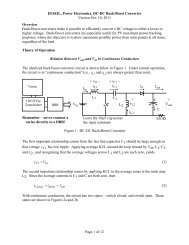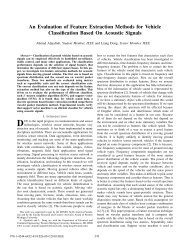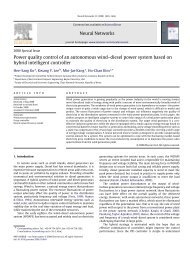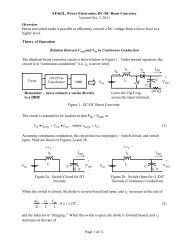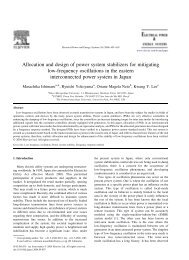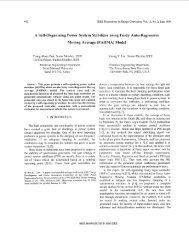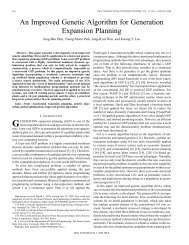The Laplace transform on time scales revisited - ECS - Baylor ...
The Laplace transform on time scales revisited - ECS - Baylor ...
The Laplace transform on time scales revisited - ECS - Baylor ...
You also want an ePaper? Increase the reach of your titles
YUMPU automatically turns print PDFs into web optimized ePapers that Google loves.
1296 J.M. Davis et al. / J. Math. Anal. Appl. 332 (2007) 1291–1307Now z →∞above yieldslim∫ ∞z→∞0f (t)e⊖z σ [ ](t, 0)t = 0 = lim zF (z) − f(0) ,z→∞i.e., f(0) = lim z→∞ zF (z).On the other hand, z → 0 yieldslim∫ ∞z→00∫∞f (t)e⊖z σ (t, 0)t =i.e., lim t→∞ f(t)= lim z→0 zF (z).1.2. Inversi<strong>on</strong> formula0f (t) t = limt→∞✷[ ]f(t)− f(0) = lim zF (z) − f(0) ,z→0Using <str<strong>on</strong>g>The</str<strong>on</strong>g>orem 1.2 we can establish an inversi<strong>on</strong> formula for the <str<strong>on</strong>g>transform</str<strong>on</strong>g>. As is the casewith T = R, these properties are not sufficient to guarantee that F(z) is the <str<strong>on</strong>g>transform</str<strong>on</strong>g> of somec<strong>on</strong>tinuous functi<strong>on</strong> f(t), but they are necessary as we have just seen. For sufficiency, we havethe following:<str<strong>on</strong>g>The</str<strong>on</strong>g>orem 1.4 (Inversi<strong>on</strong> of the <str<strong>on</strong>g>transform</str<strong>on</strong>g>). Suppose that F(z) is analytic in the regi<strong>on</strong> Re μ (z) >Re μ (c) and F(z) → 0 uniformly as |z| →∞in this regi<strong>on</strong>. Suppose F(z) has finitely manyregressive poles of finite order {z 1 ,z 2 ,...,z n } and ˜F R (z) is the <str<strong>on</strong>g>transform</str<strong>on</strong>g> of the functi<strong>on</strong> f(t) ˜<strong>on</strong> R that corresp<strong>on</strong>ds to the <str<strong>on</strong>g>transform</str<strong>on</strong>g> F(z)= F T (z) of f(t)<strong>on</strong> T.Ifthen∫c+i∞c−i∞f(t)=∣ ˜F R (z) ∣ |dz| < ∞,n∑Res z=zi e z (t, 0)F (z),i=1has <str<strong>on</strong>g>transform</str<strong>on</strong>g> F(z)for all z with Re(z) > c.Proof. <str<strong>on</strong>g>The</str<strong>on</strong>g> proof follows from the commutative diagram between the appropriate functi<strong>on</strong>spaces in Fig. 3.Let C be the collecti<strong>on</strong> of <str<strong>on</strong>g>Laplace</str<strong>on</strong>g> <str<strong>on</strong>g>transform</str<strong>on</strong>g>s over R, and D the collecti<strong>on</strong> of <str<strong>on</strong>g>transform</str<strong>on</strong>g>sover T, i.e., C ={˜F R (z)} and D ={F T (z)}, where ˜F R (z) = G(z)e −zτ and F T (z) = G(z)e ⊖z (τ, 0)C p-eo (R, R) θ θ −1C prd-e2 (T, R) L −1TL RL −1RCγL T D= θ ◦ L−1 R ◦ γ −1γ −1Fig. 3. Commutative diagram between the functi<strong>on</strong> spaces.







